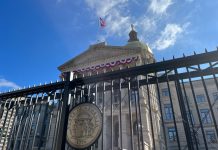
Photograph by Kevin C. Cox/Getty Images
In the month since Carrollton was shut down to prevent the spread of COVID-19, the volume at Jerry’s Country Kitchen has shrunk to less than a quarter of its usual business. Brock Eady took over the breakfast-and-lunch place from his dad about 30 years ago. He’s still paying his five employees, but is just about broke. “I’m just trying to make payroll Friday,” he says. “But we may not be able to buy food to sell.”
A few days ago, he watched at home as Governor Brian Kemp announced his plan to reopen Georgia businesses. When the governor said, “I don’t give a damn about politics right now,” Eady rewound the video so he could post a recording to Facebook.
“I’m thankful that he wants us to go back to work,” he says. “I don’t have the answer if it’s safe or not.”
Others felt considerably more certain. The mayors of several Georgia cities, including Atlanta’s, expressed concern about the order’s wisdom and encouraged their citizens to stay home. Throngs of Atlanta restaurateurs announced their intentions to stay closed. Public health cognoscenti and national media broadly condemned the decision.
Kemp said “favorable data, enhanced testing, and approval of our health care professionals” drove his decision to authorize the reopening of fitness centers, bowling alleys, body art studios, hairdressers, nail salons, massage therapists, and other personal service providers as early as Friday, April 24. (Dine-in restaurants and theaters will be allowed to reopen on Monday, April 27 under specific social distancing and sanitation conditions.)
But the existing data isn’t enough to ground such a critical decision, says Joshua Weitz, a quantitative biologist at Georgia Tech who specializes in disease dynamics. “It’s not just about looking at a number in a reported case count and saying, ‘Well, that looks flat enough that we can open up,’” he says; a better way is to consider whether current conditions allow a sustained downward curve—and if they don’t, to create better conditions.
There’s no playbook to guide leaders making the wrenching decisions they now must make: their choice is between subjecting their electorates to generational economic pain or to a plague of near-biblical proportions. Kemp’s decision suggests his priority is to salve financial wounds first—and with the kind of haste public health experts say will cost unnecessary lives.
To Kemp’s critics, the shape of Georgia’s epidemic curve is one of the greatest sources of concern. Each day, the state’s health department publishes a chart detailing the confirmed cases of COVID-19 by the date of illness onset. At first glance, the chart seems to show a downward trend in cases over the most recent week or so—but that trend doesn’t reflect reality.
It often takes days for new infections to be included in that chart, in part because people often have a fever or cough for days before getting tested for the virus causing COVID-19. Additionally, the way tests get reported to the health department can delay their inclusion in official case counts.
As a consequence of these reporting lags, what looks like a small number of cases today will grow substantially over the next week as new reports trickle in from around the state. These delays apply to COVID-19 death trends, too—a recent analysis suggested that on April 20, deaths attributed to COVID-19 were still being added to daily totals as far back as April 3.
So while Kemp said the virus is “on the downward trend,” daily case counts and fatalities have actually remained steady for the last few weeks, says Weitz. Even if there were clear evidence that Georgia had passed one peak, he says, “there’s no epidemiological rule that says there can only be one peak in an epidemic.” In diseases like COVID-19, cases can resurge or plateau after a peak—and human choices play an enormous role in the direction the curve takes.
“To those who see a trend, keep in mind that the trend is us,” says Weitz. “It’s our behavior that has led to the decrease, and if we change the behavior, there is a very high risk that there will be an increase.”
The way to avoid that increase is to build testing, tracing, and treatment infrastructure before changing our behavior. “In Georgia,” says Weitz, “almost all of us are susceptible to infection”—but survivors of COVID-19 may be less likely to become sick and contagious if they are re-exposed, potentially making them better candidates to re-enter the workforce sooner. Although scientists still have many unanswered questions about COVID-19 immunity, Weitz feels widespread testing for immunity should be a cornerstone of a successful reopening strategy.
Also important would be a strategy to identify, quarantine, and test contacts of known COVID-19 cases, known to public health authorities as “contact tracing.” This tool is critical for identifying the remaining disease hotspots once transmission rates trend downward, says Jeff Engel, executive director of the Council of State and Territorial Epidemiologists. But before attempting a contact tracing effort, states need to have “manageable” numbers of cases, says Engel—“maybe a hundred infected people for each person available to do the work. With Georgia lately averaging about 6,500 actively infected individuals on any given day, the workforce it would need to effectively trace contacts would be in the hundreds. It is unclear what progress the state has made toward this goal.
Weitz acknowledges the severe economic pressure created by the pandemic, and says the solution to those pressures is not to prematurely reopen businesses, but to provide financial aid directly to the people who are hardest hit—a process that has been delayed at the federal level. Furthermore, he said, businesses that do reopen need resources and information to help them keep employees and patrons safe. “Have they given that small business owner masks?” he asks. “Have they given the option to have at-will testing, especially for customer-facing staff? Have they given them advice on airflow?”
On Wednesday, Eady prepared to read a ten-page Georgia Chamber of Commerce document on the minimum basic operations needed to safely reopen a business; seven of its pages comprised the text of Kemp’s executive order. He’d bought his 83-year-old mother face masks at the Home Depot—she’s the “Jerry” in the restaurant’s name, and still works there almost every day. She hasn’t been wearing them.
He says he doesn’t know anyone who’s had severe health effects due to the virus, and isn’t sure what it would change if he did. “It would probably make me leery,” he says, “but the fact is, my doors have to be open.”
“My decision would still be, open this place up. Because it’s all I got.”













